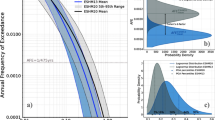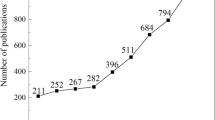Abstract
The Unified Scaling Law for Earthquakes (USLE), that generalizes the Gutenberg–Richter recurrence relation, has evident implications since any estimate of seismic hazard depends on the size of territory that is used for investigation, averaging, and extrapolation into the future. Therefore, the hazard may differ dramatically when scaled down to the proportion of the area of interest (e.g. a city) from the enveloping area of investigation. In fact, given the observed patterns of distributed seismic activity the results of multi-scale analysis embedded in USLE approach demonstrate that traditional estimations of seismic hazard and risks for cities and urban agglomerations are usually underestimated. Moreover, the USLE approach provides a significant improvement when compared to the results of probabilistic seismic hazard analysis, e.g. the maps resulted from the Global Seismic Hazard Assessment Project (GSHAP). In this paper, we apply the USLE approach to evaluating seismic hazard and risks to population of the three territories of different size representing a sub-continental and two different regional scales of analysis, i.e. the Himalayas and surroundings, Lake Baikal, and Central China regions.











Similar content being viewed by others
References
Albarello D, D’Amico V (2008) Testing probabilistic seismic hazard estimates by comparison with observations: an example in Italy. Geophys J Int 175:1088–1094
Atmanspacher H, Scheingraber H, Voges W (1988) Global scaling properties of a chaotic attractor reconstructed from experimental data. Phys Rev A 37(4):1314–1322
Bak P, Christensen K, Danon L, Scanlon T (2002) Unified Scaling Law for Earthquakes. Phys Rev Lett 88:178501–178504
Bormann P (Ed) (2012) New manual of seismological observatory practice (NMSOP-2). IASPEI, GFZ German Research Centre for Geosciences, Potsdam; http://nmsop.gfz-potsdam.de; doi:10.2312/GFZ.NMSOP-2urn:nbn:de:kobv:b103-NMSOP-2
CENC (2014) China Earthquake Networks Center Catalog. http://www.csndmc.ac.cn/wdc4seis@bj/intro/cenc/intro.jsp
GHDB (1989) Global Hypocenters Data Base CD-ROM. NEIC/USGS, Denver, CO, 1989 and updates July 2014
Giardini D, Grünthal K, Shedlock P, Zhang (1999) The GSHAP global seismic hazard map. Ann Geofis 42(6):1225–1228
Giardini D, Wössner J, Danciu L (2014) Mapping Europe’s seismic hazard. Eos Trans AGU 95(29):261–262
GPW (2005) Gridded Population of the World, Palisades, NY: Socioeconomic Data and Applications Center (SEDAC), Columbia University. http://sedac.ciesin.columbia.edu/gpw. Accessed 29 May 2012
Gutenberg B, Richter CF (1954) Seismicity of the Earth, 2nd edn. Princeton University Press, Princeton 310 p
Kossobokov VG, Mazhkenov SA (1988) Spatial characteristics of similarity for earthquake sequences: Fractality of seismicity. Lecture Notes of the Workshop on Global Geophysical Informatics with Applications to Research in Earthquake Prediction and Reduction of Seismic Risk (15 Nov–16 Dec 1988), ICTP, Trieste
Kossobokov VG, Mazhkenov SA (1994) On similarity in the spatial distribution of seismicity. In: Chowdhury DK (ed) Computational Seismology and Geodynamics/AGU, 1. The Union, Washington, pp 6–15
Kossobokov V, Nekrasova A (2010) Global seismic hazard assessment program maps are misleading. Eos Trans AGU 91(52):U13A–0020
Kossobokov V, Nekrasova A (2012) Global seismic hazard assessment program maps are erroneous. Seism Instrum 48(2):162–170. doi:10.3103/S0747923912020065
Mandelbrot B (1982) The fractal geometry of nature. Freeman, New York
Molchan G, Kronrod T, Panza GF (1997) Multi-scale seismicity model for seismic risk. Bull Seismol Soc Am 87:1220–1229
Nekrasova A, Kossobokov V (2002) Generalizing the Gutenberg–Richter scaling law. EOS Trans AGU 83(47):NG62B–0958
Nekrasova A, Kossobokov V (2005) Unified Scaling Law for Earthquakes: mega-cities and urban agglomerations. Eos Trans AGU 86(52):S23A–0229
Nekrasova A, Kossobokov V (2006) Unified scaling law for earthquakes in the Lake Baikal region. Doklady Earth Sci 407A(3):484–485
Nekrasova A, Kossobokov V, Aoudia A, Perezan A, Panza GF (2011) A multiscale application of the Unified Scaling Law for Earthquakes in the Central Mediterranean area and Alpine region. Pure Appl Geophys 168:297–327
Nekrasova A, Kossobokov V, Peresan A, Magrin A (2014) The comparison of the NDSHA, PSHA seismic hazard maps and real seismicity for the Italian territory. Natl Hazards 70(1):629–641. doi:10.1007/s11069-013-0832
Nekrasova A, Peresan A, Kossobokov VG, Panza GF (2014) A new probabilistic shift away from seismic hazard reality in Italy? Proceedings of the International School and Workshop on “Nonlinear Mathematical Physics and Natural Hazards”; arXiv:1409.1047v2 [physics.geo-ph]
Okubo PG, Aki K (1987) Fractal geometry in the San Andreas fault system. J Geophys Res 92:345–355
Panza GF, Peresan A, La Mura C (2013) Seismic hazard and strong ground motion: an operational neo-deterministic approach from national to local scale. In: UNESCO-EOLSS Joint Committee (Eds) Encyclopedia of life support systems (EOLSS), Geophysics and Geochemistry, Developed under the Auspices of the UNESCO, Eolss Publishers, Oxford, UK, pp 1–49
Parvez IA, Gusev A, Panza GF, Petukhin A (2001) Preliminary determination of the interdependence among strong motion amplitude, earthquake magnitude and hypocentral distance for the Himalayan region. Geophys J Int 144:577–596
Parvez IA, Nekrasova A, Kossobokov V (2014) Estimation of seismic hazard and risks for the Himalayas and surrounding regions based on Unified Scaling Law for Earthquakes. Natl Hazards 71(1):549–562. doi:10.1007/s11069-013-0926-1
Richter CF (1935) An instrumental earthquake magnitude scale. Bull Seismol Soc Am 25(1):1–32
Shedlock K, Giardini D, Grünthal G, Zhang P (2000) The GSHAP global seismic hazard map. Seismol Res Lett 71(6):679–686
Stein S, Geller R, Liu M (2012) Why earthquake hazard maps often fail and what to do about it? Tectonophysics 562(563):1–25
Wasserburg GJ (2010) Comment on “AGU statement: Investigation of Scientists and Officials in L’Aquila, Italy, is unfounded. Eos Trans AGU 91(42):384
Wyss M, Nekrasova A, Kossobokov V (2012) Errors in expected human losses due to incorrect seismic hazard estimates. Natl Hazards 62(3):927–935. doi:10.1007/s11069-012-0125-5
Acknowledgments
The authors acknowledge the support from the Russian Foundation for Basic Research, Department of Science and Technology of India, and GFNS of People’s Republic of China (Grants RFBR 1 13-05-91167, GFNS No. 51311120080, RFBR 1 14-05-92691, and DST No. INT/RFBR/P-176).
Author information
Authors and Affiliations
Corresponding author
Rights and permissions
About this article
Cite this article
Nekrasova, A., Kossobokov, V.G., Parvez, I.A. et al. Seismic hazard and risk assessment based on the unified scaling law for earthquakes. Acta Geod Geophys 50, 21–37 (2015). https://doi.org/10.1007/s40328-014-0082-4
Received:
Accepted:
Published:
Issue Date:
DOI: https://doi.org/10.1007/s40328-014-0082-4




